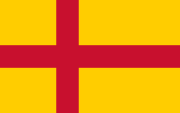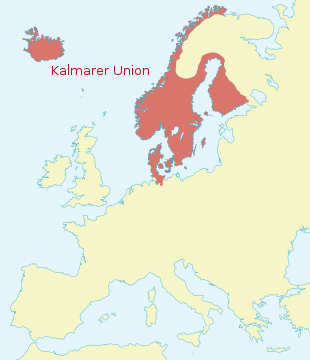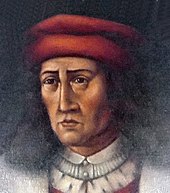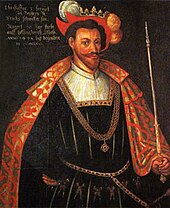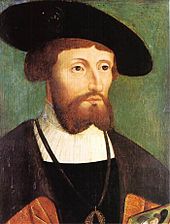Kalmar Union
| Squid unions | |||
| Kalmar Union | |||
| 1397-1523 | |||
|
|||
| capital city | Copenhagen | ||
| Head of state , also head of government | See list of the kings of Denmark | ||
| founding | June 17, 1397 | ||
| resolution | June 6, 1523 | ||
The Kalmar Union was a union of the kingdoms of Denmark , Norway, and Sweden that existed from 1397 to 1523.
The Kalmar Union , which was formally never ratified , also comprised areas of today's Finland , which was then under Swedish rule, the islands of Iceland , Faroe Islands , Shetland (also: Hjaltland) and Orkney , which were subordinate to the Norwegian crown, and at times the territories of Schleswig (also : Sønderjylland ) and Holstein . The imperial councils in Denmark, Sweden and Norway had never ratified the Union document, however, because Margaret I wanted to establish a much closer union than the nobility of the Nordic states. The islands and cities of the Union did not belong to the UnionHanseatic League , which was in economic and political competition with the surrounding monarchies. The provinces of Skåne , Halland and Blekinge in the southwest of what is now Sweden, like Bornholm, were owned by Denmark at the time.
alliance
The Kalmar Union was dominated by Denmark and only supported by parts of the nobility and clergy in Sweden and Norway. Dominant themes in the history of the Kalmar Union have always been free trade, especially that of the Hanseatic cities , the self-interests of the Swedish aristocracy and the possession of Schleswig . Due to the various interests involved, the Union could not form a major power. The union of the three Scandinavian countries, which was only created as a personal union and a defensive alliance, was not a continuously ongoing composite, since the disintegration of the 15th century frequently Unionskönigtums came. Only under the kings Erich von Pommern (1397–1439), Christoph von Bayern (1440–1448), Christian I (1457–1463) and Hans (1497–1501) did it really exist. During these periods, the reigning Danish king was also accepted as a Union king by the Swedish nobility. In the intervening periods, the Swedish Imperial Council and the Imperial Governor elected by it took over government in the country.
prehistory
Union Sweden-Norway
In Sweden, the nobility became powerful because the kingship showed weakness. The nobility agreed in 1319 to elect Magnus Eriksson , the three-year-old grandson of Magnus I and King of Norway. After a war against Denmark, Skåne , Öland and Gotland were lost.
Union Denmark-Norway
Norway was given to his younger son King Håkon VI by Magnus Erikson in 1355 . to hand over. He married Margaret I of Denmark in 1363 , the daughter of King Waldemar IV. In 1370, Denmark bowed to the Hanseatic League in the Peace of Stralsund . For their part, the Hanseatic cities support the regent Margarethe as successor to Håkon VI in order to counterbalance the up-and-coming Mecklenburg . In 1376, the regent Margaret I obtained the election of her five-year-old son Olav as King of Denmark. In 1381 he also inherited the throne of Norway after his father. After his death in 1387, the regent took over rule in both states.
Union Denmark-Norway-Sweden
Swedish aristocrats opposed their King Albrecht and chose Queen Margaret I as regent. King Albrecht was defeated in 1389 and taken prisoner with his son Erich, but the city of Stockholm resisted with the help of Mecklenburg and the Vitalienbrüdern until 1395. The Hanseatic cities of Rostock and Wismar also supported Stockholm in this. When the sea trade was damaged by the Vitalienbrüder, the Hanseatic cities intervened under the leadership of Lübeck . They took Stockholm under their administration and got their rights confirmed by Margarethe after a blockade of Scania. Mecklenburg was severely weakened by this alliance. This was followed by a conquest of Gotland by the Teutonic Order , but Gotland was soon returned to Denmark under pressure from the Hanseatic League.
story
On June 17, 1397, 67 people from the clerical and secular nobility of the three states signed the draft treaty in Kalmar under the leadership of Queen Margaret I of Denmark , which was never ratified, but which in fact united Scandinavia for around a century and a half. Each empire retained its imperial council and structure of government.
Since 1409 there was a war between Denmark and Holstein over Schleswig . The duchy had gone to the House of Schauenburg as a Danish fief from 1326-1330 and the strengthened Denmark wanted to assert its ownership claims against Count Adolf VIII of Schauenburg zu Holstein and Stormarn, which the German King Sigismund also confirmed, since 1427.
Eric of Pomerania
After Margaret's death in 1412, further problems arose when her great-nephew, king and successor Erich von Pommern- Stolp caused a break with the Hanseatic League. Although he intervened in the constitutional conflict of Wenden in the interests of the old council, the Hanseatic League did not want to support his claim to Schleswig. Erich von Pommern therefore allied himself with Poland against the Teutonic Order and levied taxes on the Oresund, the Sundzoll . As a result, the Hanseatic League and Holstein were disadvantaged, and England and Holland were preferred. The Hanseatic League openly supported the Counts of Holstein .
In the war of the Kalmar Union against the Hanseatic League and Holstein in 1427, a Hanseatic fleet was defeated by the Danes in the Sund and the mayors of Hamburg and Lübeck were captured. Another attack by the Hanseatic League on Copenhagen in 1428 failed, and a Danish attack on Stralsund in 1429 ended with defeat in the naval battle at Dänholm . A Wendish fleet sacked Bergen . Erich von Pommern came to an understanding with the Teutonic Order and was even able to get Novgorod on his side from the neutral Hanseatic cities in the east . He also received support from Holland in the developing pirate war . Rostock and Stralsund signed a separate peace in 1430, Flensburg was conquered by Holstein in 1431 .
In addition, Erich von Pomerania wanted to transform the Union into a unitary state governed from Copenhagen . There were popular surveys in Sweden as early as 1434. It was only when the leader and current national hero Engelbrecht Engelbrechtson was murdered in 1435 that the uprising collapsed. The Swedish nobility then appointed Karl Knutson Bonde as the imperial administrator of Sweden until 1441, who continued to act against Denmark and later became king.
The Swedish uprising forced Erich von Pommern to make peace with Vordingborg in 1435 . The Holstein-Rendsburg line of the house of Schauenburg kept the Duchy of Schleswig, the Hanseatic League got its privileges confirmed and the Wendish and Pomeranian ships, unlike the ships of the Pruzzen and Livlanders, who were neutral during the war, were to be exempted from the Danish sound tariff. This promised freedom was later denied to the Wendish traders.
Erich von Pommern was no longer able to assert his power and withdrew to the island of Gotland and later to Pomerania.
Christopher III.
In 1439 the Imperial Council of Denmark met in the Hanseatic city of Lübeck and deposed Erich von Pomerania as king. His Bavarian nephew Christoph von Neumarkt was chosen as his successor . After the Hanseatic League had its rights confirmed, a ship from Lübeck brought it to his new empire. Sweden and Norway had since terminated the union. In 1440 he was also elected in Sweden, and in 1442 he was recognized as king in Norway.
In 1441 there was a peasant uprising in North Jutland . After initial losses, Christoph achieved the decisive victory on June 8th against the wagons of the rebels at Husby Hole.
Because of the sound tariff , there were ongoing disputes between the Baltic Sea powers. Christopher III. granted Holland the same rights as the Hanseatic League, took customs duties from Prussia. Lübeck and Rostock then closed their gates to him.
The Swedish aristocracy also increasingly resisted Danish power politics. On the one hand, there were nationalist tendencies in Sweden that encouraged a break with Denmark and, on the other hand, the Swedish nobility feared the restriction of their rights and freedoms by Danish politics. The main points of contention were the rigorously implemented tax policy and the occupation of the Swedish castles and bishoprics with foreign, mostly Danish, nobles. With these actions, the Danish kings regularly violated the agreements made with the Swedish nobility, which ultimately even led to the election of a Swedish opposing king, Karl Knutson Bonde .
Karl Knutson Bonde and Christian I.
After the death of Christoph of Bavaria in 1448, the Swedish imperial administrator Karl Knutson Bonde was elected king by mutual agreement with Norway. Sweden recaptured Gotland , from which Erich von Pommern acted as a pirate. In 1449 Karl Knutson was also crowned King of Norway.
In 1448, in agreement with the Hanseatic League and the Wendish cities, the Danes elected the German Christian I from the House of Oldenburg as king. Christian tried to retake Gotland and a war broke out between Denmark and Sweden from 1451 to 1456. In addition, there had been war in the Baltic Sea since 1454 between the Prussian estates and the Teutonic Order.
Denmark secured the support of foreign powers such as B. the Hanseatic League, the Teutonic Order or Holland . It also had the support of a group in the Swedish aristocracy (e.g. Oxenstierna) who clung to the Union primarily for economic reasons. Many nobles owned large estates on both the Danish and the Swedish side. When this Union-friendly group became too strong, King Karl Knutson fled to Danzig in 1457 .
Christian I from the House of Oldenburg was also crowned King of Sweden in 1457. By mutual agreement with the Hanseatic League, a traffic peace alliance was concluded for the whole of the Baltic Sea, only disturbed by the dispute in the countries of the Order. In 1459 Christian I, the nephew of Adolf VIII., After his death, became Duke of Schleswig and Count (from 1474 also Duke) of Holstein at the request of the local knighthood. This strengthened his position vis-à-vis the Hanseatic League, as his domain now included Hamburg , controlled the land route between the Baltic and North Sea and reached as far as Lübeck , which was the leading Hanseatic city.
In Sweden, the citizens of Stockholm , the mining and smelting entrepreneurs and the farmers of Dalarna proved to be dissatisfied with the Danish tax policy, so that under high aristocratic leadership there were several uprisings, the first time in 1464. Karl Knutson Bonde had returned to Stockholm and was again recognized as king. The Swedish nobility banished him to Finland in 1465, but also took a negative attitude towards Christian I. He also had to defend himself from 1463 against his brother Gerd, who demanded Schleswig-Holstein and finally received it as administrator. For the unsuccessful fight Christian I. pledged Fehmarn and Neustadt in Holstein to Lübeck. In 1467 Karl Knutson worked again in Stockholm and Christian tried in vain to attack Sweden. Christian I. Lübeck left the city of Kiel to the city of Kiel in 1469 for an attempt at mediation desired by the two kings, which then did not take place . Christian I had meanwhile deposed his brother after further claims to power, had him captured and driven into piracy.
Karl Knutson died in Sweden in 1470. But then his nephew (son of his stepsister) Sten Sture I. became Reichsverweser. Christian landed with troops before Stockholm in July 1471, but suffered a significant defeat against Sten Sture at the Battle of Brunkeberg . Only in 1473 was there a peace between Denmark and Sweden in Kalmar. In 1474 Christian I tried to get the support of the Roman-German Emperor Friedrich III. secure for some endeavors, but his power was broken. Sten Sture the Elder remained imperial administrator until 1497 and took on this task again from 1501–1503. This was followed by Svante Sture until 1512. After Erik Trolle's brief tenure , Sten Sture the Younger was appointed imperial administrator in 1512. It was not until 1520 that Christian II was the last common king of the Union.
Johann I.
King Hans ruled from 1481 to 1513, but was only partially recognized as head in Sweden and had to fight off further uprisings there. Lübeck's support for the Swedes resulted in the Danish-Hanseatic War (1509–1512) .
Christian II
The Danish King Christian II, who had ruled since 1513, tried to subjugate Sweden again from 1517. In 1520 he defeated Sten Sture the Younger in a battle in which the latter was mortally wounded. The uprising collapsed and Christian promised amnesty.
On November 4, 1520 Christian II was crowned King of Sweden in Stockholm. The Swedish aristocrats and citizens who had previously been in opposition to Denmark also came to the three-day festival. On November 7th they were arrested and accused of heresy by Archbishop Trolle , who had been deposed in 1517. In Stockholm Bloodbath of the Imperial Council were convicted and killed more than 80 leading Swedish opposition nobles and church officials. As a result, the population rose across Sweden.
In 1521 Danish influence was pushed back from the empire, and in 1523 Sweden left the Kalmar Union for good with the election of Gustav I. Wasa as king. The Danish-Norwegian personal union lasted until 1814.
coat of arms
Seal of Erik VII of Pomerania from 1398
The Dannebrog Cross has been part of the monarch's coat of arms since the time of Erik VII of Pomerania; the same is true of Norway's ax-carrying lion and the heraldic symbols of Sweden. The three crowns were actually the coat of arms of Sweden , but then also symbolized the three Nordic kingdoms of the Kalmar Union. In the cross-divided main shield of Erik VII's seal are the three Danish lions surrounded by hearts at the top left, the three crowns at the top right, which, like the Folkung lion, stand over three narrow sloping beams for Sweden and at the bottom the Pomeranian griffin. The ax-carrying lion of Norway appears in the heart shield.
Supplements during the Kalmar Union
In 1449 Christian I added a lion over nine hearts for the title of "the Goths", presumably as part of his efforts to rule over Sweden, where the patriotic myth of the Swedes as descendants of the victorious Goths contributed significantly to the national self-image. For the title "the Wends" the dragon-like lindworm was added in 1440, which symbolizes paganism and can thus refer to the earlier victory over the pagan Wends. The two Oldenburg beams were added to Christian I's coat of arms; The Delmenhorst cross also appears in the royal coat of arms from the time of Frederik I. The two Schleswig lions have been known since 1245 and became part of the monarch's coat of arms in 1460; likewise the Holstein Nesselblatt , which was originally the coat of arms of the Schauenburgers. Other coat of arms fields were used: the Agnus Dei from Gotland , the eagle from Ösel , the crown of Fehmarn and the Bornholm dragon. Bull horns, sometimes covered with ermine , decorated with peacock feathers were royal crests from the end of the 13th century to the 20s of the 15th century.
See also
- Sweden in the time of the Kalmar Union
- Flag of the Kalmar Union
- History of Denmark
- History of Norway
- History of Sweden
- Swedish National Day
literature
- Sverre Bagge, Knut Mykland: Norge i dansketiden. 1380-1814. 2. utgave, 4. opplag. Cappelen, Oslo 1996, ISBN 82-02-12369-0 .
- Halvard Bjørkvik: Folketap og sammenbrudd, 1350–1520 (= Aschehougs Norgeshistorie. Vol. 4). Aschehoug, Oslo 1996, ISBN 82-03-22017-7 .
- Geir Atle Ersland, Hilde Sandvik: Norsk historie 1300–1625. Eit rike tek form (= Samlagets norsk historie 800–2000. Vol. 2). 2. opplag. Det Norske Samlaget, Oslo 2005, ISBN 82-521-5182-5 .
- Detlef Kattinger et al. (Ed.): "Huru thet war talet j kalmarn". Union and Cooperation in Nordic History. 600 years of the Kalmar Union (1397–1997) (= Greifswald historical studies. Vol. 2). Publishing house Dr. Kovac, Hamburg 1997, ISBN 3-86064-584-6 .
- Karl Pagel : The Hanseatic League. Georg Westermann Verlag, Braunschweig 1983, ISBN 3-14-508879-3 .
- Oliver Auge : An integration model from the north? The example of the Kalmar Union (in: Questions of political integration in medieval Europe . Ostfildern 2005, pp. 509-542) online .
Web links
Individual evidence
- ↑ Imhof, Arthur, Grundzüge der Nordic Geschichte, Darmstadt 1970, p. 71.
